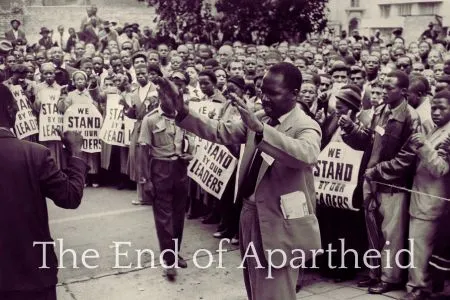On this day 32 years ago, Nelson Mandela was elected president of South Africa, becoming the first black ruler of the country since its colonization centuries ago. This was more than just a token move though and was seen as the official end to apartheid, a racist and repressive policy that had marginalized the majority black population of the country.
Nelson Mandela Struggle for Equality
Nelson Mandela was perhaps the most important figure in bringing an end to apartheid, a segregation policy created by the white-minority government in South Africa in 1948. Nelson was born in 1918 in Mvezo, South Africa, and spent most of his life under this policy. This left him well aware of the horrific injustice that millions of South Africans experienced. This inspired him to study law at the University of Witwatersrand, where he met other future anti-apartheid leaders.
With this connection and the education to help him, Mandela joined the African National Congress (ANC) in 1943 and became an outspoken member. within a year, he created the ANC Youth League, which fought for racial equality through activism. This was first seen in the anti-apartheid movement during the 1952 Defiance Campaign. it was this moment that supposedly signaled the mass protest against the policy.
However, the minority government wouldn’t give up power so easily and during the 60s, the ANC would be outlawed, forcing the part to go underground. Rather than let this stop him, Mandela organized the Umkhonto we Sizwe in 1961. This was the military wing of the party meant to face the government forces through sabotage.
While brave, these actions led to his arrest in 1962, and was given a life sentence two years later. In total, Mandela spent 27 years in prison, becoming a symbol of resistance against oppression. Although he was no longer free, the movement he began would continue to fight for equality for many years.
International Pressure and Negotiations: The End of Apartheid

By the 90s, things were getting so bad that the government was forced to release him and he spearheaded ANC negotiations with the ruling government to end apartheid. In the end, Mandela was elected South Africa’s first black president in 1994 during its first democratic elections.
His presidency was focused on bringing the different racial groups together and addressing the human rights abuses. Though he would retire from politics, Nelson Mandela would continue to push these advocates until his death in 2013.
The negotiations culminated in the first democratic elections in South Africa’s history in 1994. The world watched with anticipation as Nelson Mandela, the formerly imprisoned leader of the resistance, emerged victorious. His inauguration as the country’s first Black president marked a defining moment: a new era of hope and reconciliation had begun.
Mandela’s presidency focused on fostering national unity and healing the deep wounds inflicted by apartheid. The Truth and Reconciliation Commission (TRC) was established in 1995 to investigate human rights abuses committed by both sides during the apartheid era. The TRC aimed to promote healing and forgiveness while ensuring accountability for past wrongs.
Mandela’s decades in prison were marked by personal sacrifices and profound reflections. His letters from prison reveal the depth of his commitment to freedom and justice. One poignant letter, written to his friend and fellow activist Desmond Tutu, reflects his enduring hope and determination:
Dade Wethu,
A novel by Langenhoven, “Skaduwees van Nasaret” [Shadows of Nazareth], depicts the trial of Christ by Pontius Pilate when Israel was a Roman dependency and when Pilate was its military governor. I read the novel in 1964 & now speak purely from memory. Yet though the incident described in the book occurred about 2,000 years ago, the story contains a moral whose truth is universal & which is as fresh and meaningful today as it was at the height of the Roman empire. After the trial, Pilate writes to a friend in Rome to whom he makes remarkable confessions. Briefly this is the story as told by him, & for convenience, I have put it in the first person…
–Nelson Mandela, Former President of South Africa
Nelson Mandela stepped down as president in 1999, but his legacy continues to inspire generations. His unwavering commitment to justice, racial reconciliation, and forgiveness paved the way for a more equitable South Africa. Mandela’s story serves as a powerful reminder that even in the face of seemingly insurmountable odds, the fight for freedom and equality can ultimately prevail.
If you want to create vintage letters that look fit for the queen, our Vintage Letter platform can let you create some beautiful letters that you can try here.
